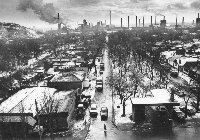Degradation of a Competitive Industry

Last week the financial and payment crisis, antidumping cases abroad, biting frost, and the government have almost destroyed Ukrainian metallurgy. An emergency management headquarters has been set up in the Ministry of Industrial Policy. Representatives of steel manufacturers from Ukraine, Russia, and Belarus gathered in Pushcha-Ozerna near Kyiv to consider how to resist being elbowed out of the world market. According to Anatoly Kinakh, head of the Ukrainian Association of Industrialists and Entrepreneurs, Ukraine risks losing revenues of $120 million in the sector.
Vadym Hurov, Deputy Chairman of Parliament's Industrial Policy Committee, told The Day: "Today's metallurgy is a dying swan. Take Kryvorizhstal [Kryvy Rih Steel]. I was head of a workshop there. Only one of its six open hearth furnaces is still working. All told, the steel and iron industry is slowly but surely coming to a halt, physically as well as morally, despite the fact that this is Ukraine's only sector still considered competitive on the world market. However, while bringing in foreign currency, Ukrainian metallurgy is losing, because our costs are substantially higher than the prices of the goods we export.
"Here is the dynamic of metallurgical revenues: it was planned to receive $3.7 million in 1997; $4.5 million in 1998, and in 1999 the draft budget envisions $5.1 million. This will exhaust the industry, because all these figures are based on the losses sustained by the steel works. In other words, they are squeezing the last drops of blood out of them."
Expert estimates show that the domestic costs of certain types of rolled stock were 20-50% higher than the export ones before the crisis. Now that the crisis is here the gap has widened, with transportation costs jumping 1.5 times, being now 15% of the metal's par value. Contrary to Cabinet assurances, natural gas costs are on the rise, and so are the prices of domestic coke, bringing up the costs of metallurgical products, while domestic market demand is shrinking.
About a month ago, Parliament, prompted by the Cabinet, passed a resolution on measures to get the mining and steel complex out of crisis. Certain tax exemptions were granted and differentiated transport and energy costs were promised. Privatization was suspended.
Says Vadym Hurov: "As for privatization in the steel and iron industry, it has deadlocked. Here the property is actually owned by no one. The state does not manage it, and we cannot find another effective owner: the mining-steel complex is in a condition in which legal privatization is too risky. We need a lot of money, because our fixed assets are depreciated by 70%. I think that metallurgical enterprises should be owned by the state or by the treasury. The trouble with the metallurgical complex is that we received it from the USSR as a very energy-intensive sector. Half its enterprises should have been closed down, phased out, and forgotten all about, because they make nothing but expenses. Instead, giants like Azovstal, the Illich and Dzerzhinsky Works, Kryvorizhstal, Zaporizhstal, Dniprospetstal, and the Donets Steel Combine should be left and used to best advantage. Then how about Makiyivka with its 400,000 jobs? The town has practically only one metallurgical plant. And the same is true of other places where metallurgical projects actually started the populated area. What we need is restructuring, but it has to be made with the emphasis on the social aspect. A decline in heavy industry must be accompanied by an upsurge in light manufacturing. And what have we done in this direction? Nothing."
Quite a number of experts insist that the current and previous Cabinets concentrated on cadre reshuffling. A graphic example is the service record of Valery Sakhno, recently appointed director of Azovstal.
In 1995, he was dismissed as Azovstal's chief engineer, reportedly for supporting the idea of merging with the Illich Steel Combine, put forth by Volodymyr Shcherban, then head of the oblast state administration. After that he worked for three years as general director of the Alchevsk Metallurgical Combine. Toward the end of August he was retired by the then Prime Minister for lack of activity in paying what he owed the state budget.
During the campaign to squeeze out debts managers of the largest mining and enrichment combines that had at one time cooperated with the Unified Energy Systems were retired. Then came the steel industry's turn. Volodymyr Severniuk, general director of Kryvorizhstal, was fired in early November, allegedly for failing to repay a 1992 German loan. Now let us compare the performance of Kryvorizhstal and Azovstal, whose director Oleksandr Bulianda was recently given an honorary discharge, retiring "for reasons of health," along with an order For Outstanding Production Merits, 2nd Class. Azovstal's pig iron output in the first ten months of 1998 was 77% that of 1997. Kryvorizhstal registered 98%. During the same period steel production fell to 80.8% at Azovstal and 96.7% at Kryvorizhstal; bar output: 79.9% and 99.2%, respectively. In other words, Mr. Severniuk should have expected a medal at least, the more so that Vadym Hurov describes him as a highly professional and resolute production administrator who managed to set the enterprise on a steady output level.
At present, cadre and property redistribution is at its peak. Valery Pustovoitenko, dealing with pro-Lazarenko Dnipropetrovsk oblast, is resuscitating the manganese holding idea. Blocks of shares are changing hands under the guise of production expedience and national interests. The stronger the gambling spirit in the industry, the weaker its performance and the larger the number of people getting pink slips.
At last week's Pushcha-Ozerna round table, Deputy Industrial Policy Minister Serhiy Hryshchenko stated that the Ukrainian steel industry production capacities are being used by only 30-50%. 31 of 50 blast furnaces, 13 converters, and 52 out of 66 rolling mills are operating. However, this year saw a good start in the industry, he added, but then an excruciating blow was dealt by the crises in Southeast Asia and Russia. In his opinion, one of the reasons for the crisis in the steel industry is a change in the situation with the domestic consumers.
Today, metallurgy's share in gross production output is 27.2%; that of the machine-building sector, 8.9%. In 1990, machine-building indices were 2.5 times higher than in metallurgy. Over the past eight years metallurgical output has dropped by one half and that of machine-building more than five times. Machine-building, transport, coal industry, and capital development consume less than 20% of the metal they used to.
In Mr. Hryshchenko's words, there is practically no domestic steel market in Ukraine. Out of 19 million tons of rolled stock 4.9 went to domestic consumers. This is an official statistic and actual figures are even more depressing as much metal falls in the hands of middlemen. In this situation Ukrainian metallurgy is held hostage.
Experts claim that Ukraine needs genuine restructuring in the steel
and iron industry, allowing for domestic and foreign needs, profitability,
and ecological standards. Without all this the obsolete industry will become
a source of environmental threat to all Europe and Ukrainian steel workers
will become a dangerous, explosive social stratum.
Newspaper output №:
№45, (1998)Section
Day After Day





